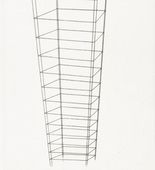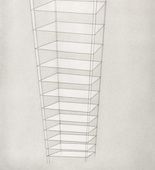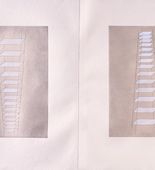
Cat. No. 1073.3 (study e)
The Puritan: study #19 of 59
- State/Variant:
- Version 3 of 3, only state, unique variant
- Date:
- 1990-1997
- Series:
The Puritan: studies #1-59
- Alternate Title:
Where from Is This Construction Seen...
- Themes
- Abstraction
- Techniques
- Engraving
- Support:
- Handmade Twinrocker paper, with Japan Gampi chine collé (5 attached sheets)
- Dimensions:
- plate (a through e) (each): 16 13/16 × 10 7/8" (42.7 × 27.7 cm); sheet (overall): 25 1/2 × 98 7/16" (64.7 × 250.1 cm)
- Signature:
- panel (e): "Louise Bourgeois." lower right margin, pencil.
- Publisher
- Osiris
- Printer
- R.E. Townsend Studio , Gravure , Wingate Studio , Renaissance Press , Chestnut Street Press
- Edition:
- Unique
- Edition Information:
Due to the complicated nature of "The Puritan" and how the project evolved with the publisher, background information is needed to understand the full edition. Benjamin Shiff approached Bourgeois in 1988 about an illustrated book project in association with The Limited Editions Club, after having seen a copy of "He Disappeared into Complete Silence," seen below in Related Works in the Catalogue, at The Museum of Modern Art. They met and discussed possible authors and texts, with Shiff suggesting Eugène Ionesco as one possibility. Bourgeois suggested Charles Baudelaire as a historical choice and Gary Indiana as a contemporary one. She finally showed Shiff two texts she had written years earlier. They chose one from 1947, "The Puritan," which Shiff eventually published under his own imprint, Osiris, New York. The subject of "The Puritan" is Alfred H. Barr, Jr., founding director of The Museum of Modern Art and Bourgeois's friend for many years.
To help Bourgeois prepare for the project, Shiff provided test plates prepared with soft ground and with hard ground. He often sat with her while she drew on these plates. Ultimately, Bourgeois chose to illustrate "The Puritan" with engravings based on a 1988 series of drawings executed, sometimes on colored papers, in pencil, gouache, and colored inks. Since the drawings incorporated color, printing experiments were initially attempted with colored inks and colored chine collés. (These can be seen in some of the earlier states.) The engraving plates were executed with the assistance of Christian Guérin, of Gravure, New York, and most impressions of the early versions and/or states and variants were printed by Guérin. Edition printing was divided among several printers because of the size and extended nature of the project. For this reason, the publisher has not designated a particular printer or printers for individual plates (see Printer).
As editioning for the illustrated book proceeded, Bourgeois went on to arrange "The Puritan" plates in several additional formats. All 4 formats of the project are noted below, and examples are included in the Evolving Composition Diagram for each plate. For the illustrated book, folio, and triptych formats, multiple examples are shown to demonstrate the variety of the hand additions. For the studies format, all 59 unique works are shown.
Illustrated books:
The colophon does not reflect the true edition of the illustrated book format, as the project continued to evolve after it was printed.
From a projected edition of 70 bound volumes, 63 were assembled.
(25 volumes with hand additions; 38 volumes without hand additions)
This edition does not include books with the following impression numbers: 19, 38, 39, 40, 41, 42, and 43, as these 7 volumes were never assembled.
The editioning process for this format was lengthy and the exact date of the hand additions is not known. The Louise Bourgeois Studio and the publisher therefore consider 1990 to be the date of publication for all works in this format.
The 5 unbound volumes described on the colophon evolved into the folio format described below.
There is 1 known maquette of the illustrated book, outside the edition. Some plates have paper collage. The plates from the maquette can be seen in the Evolving Composition Diagram for each plate.
Folio sets:
Edition of 7 sets, comprised of each plate and its corresponding text appearing side by side.
(6 sets with hand additions; 1 set without hand additions)
Triptych sets:
Edition of 12 sets, comprised of two impressions of each plate, one on either side of its corresponding text.
(All sets with hand additions)
Studies set:
57 multi-panel works and 2 single-panel works, all comprised of plates from "The Puritan" project, and all with hand additions. Texts from “The Puritan” are not included in this format.
Of the 59 studies, 46 use impressions of one plate and are on the Evolving Composition Diagram of the plate used. The remaining 13 studies combine impressions of 2 different plates and can be seen in Related Works in the Catalogue for each plate used.
About the studies set:
According to Osiris, the idea to make the studies set of unique works came to the artist after she added hand additions to an impression of plate 1, which can be seen in the Evolving Composition Diagram for plate 1 of 8.- Impression:
- Study #19 of 59
- Background:
In 1989-1990, Bourgeois began to work with the French printer, Christian Guérin of Gravure, New York. She admired Guérin's printing facilities and also felt a personal rapport with him. He helped her develop plates for several projects at that time, including the compositions that eventually illustrated "The Puritan."
- Curatorial Remarks:
- With the exception of study #22 in the MoMA Collection, the images of the studies are scans of transparencies made by Osiris.
The hand additions, paper type, and impression number could not be fully documented because this work is not in MoMA’s Collection and could not be examined in person. The plate dimensions are from an impression in MoMA’s Collection. The overall sheet dimensions were provided by the Louise Bourgeois Studio. - Description:
- Engraving, with selective wiping and chine collé, and gouache, watercolor, and ink additions
- State Changes and Additions:
- Changes from version 2: composition rendered on a new plate at a slightly smaller scale, in engraving.
Matrices:
In this 5-panel work, the orientation of the plate differs from the illustrated book format in panels (a) and (c). - Artist’s Remarks:
"With 'The Puritan' I analyzed an episode forty years after it happened. I could see things from a distance... I put it on a grid. Geometry was a tool to understanding... it was a pleasure... there was order. Instead of feeling a person drowning, I considered the situation objectively, scientifically, not emotionally. I was interested not in anxiety, but in perspective, in seeing things from different points of view. Looking and seeing... you look as you intend to look... you see what you can.
There is Euclidean geometry, but there are also a number of other geometries so you can have a way out from the rigidity of the Euclidean towards freedom. The Euclidean is comforting because nothing can go wrong... but it is not the geometry of pleasure. To survive you must have different routines... different geometries. But geometry is a tool... only a tool. It is a means, not an end.
All these plates are different. These are optical illusions... all have more than one meaning. You have one reality and I have another reality. How much liberty will the geometry take... how much will you take? What are the limits before it snaps? There is always the fear of losing consciousness of one's limits.... But the optical illusions are comforting... they have a measure of secrecy... people don't know what you are talking about. They force you to adjust your vision. You can not be so rigid... you must adjust to the picture." (Quotes cited in Wye, Deborah and Carol Smith. "The Prints of Louise Bourgeois." New York: The Museum of Modern Art, 1994, p. 191.)- This Work in Other Collections:
- Harvard Art Museums, Cambridge (study #14)
The Miriam and Ira D. Wallach Division of Art, Prints and Photographs, The New York Public Library (study #40)

1990-1997
Untitled, plate 2 of 8, from The Puritan
1990-1997
Source
1988


Where From Is This Construction Seen...
1988

Where From Is This Construction Seen...
1988
Medium: Ink on paper
Dimensions: sheet: 11 × 8 1/2" (27.9 × 21.6 cm)
© The Easton Foundation/VAGA at ARS, NY
Source
1988


Untitled
1988

Untitled
1988
Medium: Ink and pencil on tracing paper
Dimensions: sheet: 24 × 18" (61 × 45.7 cm)
© The Easton Foundation/VAGA at ARS, NY
Series
1990
Series
1990-1997
Series
1990-1997
Related Works in the Catalogue
Related Works in Other Mediums


Untitled
c. 1988

Untitled
c. 1988
Medium: Charcoal on paper
Dimensions: sheet: 15 1/2 x 11 1/4" (39.4 x 28.6 cm)
© The Easton Foundation/VAGA at ARS, NY


Seen from Above
1988

Seen from Above
1988
Medium: Ink on paper
Dimensions: sheet: 8 1/4 × 5 1/8" (21 × 13 cm)
© The Easton Foundation/VAGA at ARS, NY


Seen from Below
1988

Seen from Below
1988
Medium: Ink on paper
Dimensions: sheet: 8 1/4 × 5 1/8" (21 × 13 cm)
© The Easton Foundation/VAGA at ARS, NY


Untitled
1988

Untitled
1988
Medium: Ink on paper
Dimensions: sheet: 8 1/4 × 5 1/8" (21 × 13 cm)
© The Easton Foundation/VAGA at ARS, NY


Untitled
1988

Untitled
1988
Medium: Pencil on paper
Dimensions: sheet: 8 1/4 × 5 1/8" (21 × 13 cm)
© The Easton Foundation/VAGA at ARS, NY


Untitled
1988

Untitled
1988
Medium: Ink on paper
Dimensions: sheet: 15 1/4 × 11 1/4" (38.7 × 28.6 cm)
© The Easton Foundation/VAGA at ARS, NY


Untitled
1988

Untitled
1988
Medium: Ink on paper
Dimensions: sheet: 13 × 10 1/4" (33 × 26 cm)
© The Easton Foundation/VAGA at ARS, NY


Untitled
1997

Untitled
1997
Medium: Crayon, pencil, and gouache on paper
Dimensions: sheet: 12 x 9" (30.5 x 22.9 cm)
© The Easton Foundation/VAGA at ARS, NY


Untitled
2002

Untitled
2002
Medium: Gouache, tempera, and ink on paper
Dimensions: sheet: 76 5/8 × 29" (194.6 × 73.7 cm)
© The Easton Foundation/VAGA at ARS, NY


































































